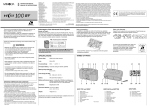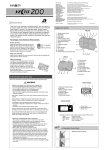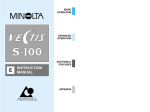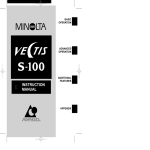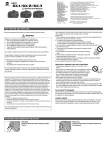Download Minolta VECTIS 40 Instruction manual
Transcript
2208_E 24/10/97 10:29 AM E Page 1 INSTRUCTION MANUAL 2208_E 24/10/97 10:29 AM Page 2 ADVANTAGES… Thank you for purchasing the Minolta Vectis Weathermatic. The Vectis Weathermatic is a water resistant Advanced Photo System™ camera designed to take pictures anywhere you go. Its housing is sealed to prevent entry of moisture and dust, so you can enjoy taking pictures on the ski slope, at the beach, or even underwater (approx. 10m (33 ft.)). Your camera has been designed to be water resistant when used as described in the manual. Careless handling however, may allow water to enter the camera causing permanent damage to internal parts. To obtain the best performance from your camera, read the instruction manual thoroughly. • Advanced Photo System™ is a trademark of the five system developing companies. OF THE ADVANCED PHOTO SYSTEM New processing.... New print formats... Classic C print, wider H print, and panorama P print formats are available with Advanced Photo System cameras. Easier to load... Advanced Photo System cameras use the new IX240 type film. This new film features drop-in-loading to make loading your camera simple, the first time, every time. Indicators on the top of the cassette tell you if the film is unexposed, partially exposed, exposed, or processed. In addition to returning your prints in the format you selected, certified photofinishers will return your Advanced Photo System film in its original cassette with an index print. To order reprints, simply choose the images you want from the index print. No more searching through negatives to find the right frame. 1 2208_E 24/10/97 10:29 AM Page 2 TABLE OF CONTENTS For Proper and Safe Use 4 Using In /Around Water 6 Operating Conditions 12 Names of Parts 14 Attaching and Removing the Strap 17 Installing the Battery 18 Loading Film 21 2 Taking Pictures 25 Taking Pictures Underwater 28 For Closer Subjects 29 Special Focus Situations Focus Hold 30 Date Imprinting Imprinting the Date or Time Setting the Date and Time Changing the Date/Time Format 41 42 44 32 Self-Timer 46 Caring for your Camera 48 Lab Services 50 Specifications 52 Using the Built-in Flash Red-eye Reduction Manual Fill-Flash Flash Cancel Night Portrait 36 37 37 38 Rewinding the Film Auto Rewind Manual Rewind 39 40 3 2208_E 24/10/97 10:29 AM Page 4 FOR PROPER AND SAFE USE Read and understand all cautions and warnings before using this product. WARNING FOR PROPER AND SAFE USE Immediately remove the battery and discontinue use if… • the camera is dropped or subjected to an impact in which the interior is exposed. • the camera emits a strange smell, heat, or smoke. Batteries may become hot or explode due to improper use. • • • • Use only the battery specified in this instruction manual. Do not install the battery with the polarity (+/-) reversed. Do not subject the battery to fire or high temperatures. Do not attempt to recharge, short, or disassemble. Do not disassemble. Electric shock may occur if a high voltage circuit inside the camera is touched. Take your camera to a Minolta Service Facility when repairs are required. Use caution, accidents may occur when using this product near young children. Keep batteries and other things that could be swallowed away from young children. Contact a doctor immediately if an object is swallowed. 4 5 2208_E 24/10/97 10:29 AM Page 6 USING IN/AROUND WATER This camera is water resistant and can be used in the rain, snow, or underwater to a depth of approx. 10 meters (33 ft.). However, careless handling may cause irreparable damage not covered by the warranty. USING IN /AROUND WATER • Do not jump or dive into the water while holding the camera. Please observe the following cautions: • Do not hold the camera under running water. • Do not surf with the camera. 10m (33 ft.) • Do not throw the camera. • Do not take the camera to depths greater than 10m (33 ft.). 6 7 2208_E 24/10/97 10:29 AM Page 8 USING IN/AROUND WATER • Clean and dry the camera before opening the film and battery chambers. • Do not load film or replace the battery in places where water, blowing sand, or dust can enter the camera. USING IN /AROUND WATER • The gaskets will be damaged if the camera is not washed in fresh water after exposure to salt water. • The surface of the camera can be damaged if sunscreen and tanning lotions are not removed immediately. • Clean the camera by immersing it in a small volume of fresh water. • Keep hands, film, and battery clean and dry when inserting or removing the film or battery. 8 • Do not use compressed air or a hair dryer to dry the camera. 9 2208_E 24/10/97 10:29 AM Page 10 USING IN/AROUND WATER USING IN/AROUND WATER The interior of this camera is not water resistant. Gasket Battery Chamber Gasket • Clean the gaskets and joining surfaces before closing covers. • Inspect the gaskets and joining surfaces every time the film or battery chambers are opened. If the seals are brittle, cracked, or discolored, the camera may leak. Contact an authorized Minolta Service Facility to have the gaskets replaced. Joining Surface • Remove foreign matter from the gaskets with a clean, dry cloth. • Make sure the covers close tightly. Film Chamber Gasket 10 11 2208_E 24/10/97 10:29 AM Page 12 OPERATING CONDITIONS OPERATING CONDITIONS OPERATING CONDITIONS FILM CASSETTE WARNING • This camera is designed for use from -10 to 40 °C (14 to 104 °F). • Never leave your camera where it may be subjected to extreme temperatures such as inside the glove compartment of a car. • At colder temperatures, the data panel response time will be slow. At higher temperatures, the display may temporarily darken, but will restore when the temperature normalizes. • To prevent condensation from forming inside the camera when bringing the camera from an extremely cold area to a warm area, let the camera come to room temperature before opening the film or battery chambers. • When photographing in cold weather, keep the camera and spare batteries inside your coat to keep them warm when you are not shooting. Cold batteries will regain some of their charge when they warm up. 12 The film used in Advanced Photo System cameras stores some data magnetically. Do not place the film cassette on or near anything that creates a magnetic field, such as a television or stereo speakers. CAMERA ERROR If the camera will not function with a fresh battery, remove the battery, wait a few minutes, then reinsert it. If normal operation does not resume or the camera malfunctions repeatedly, contact an authorized Minolta Service Facility. 13 2208_E 24/10/97 10:29 AM Page 14 NAMES OF PARTS Body Control dial NAMES OF PARTS Data panel Film-chamber lock Tripod socket Zoom lever Film-chamber door Flash* Shutter-release button Battery-chamber lock Viewfinder window* Red-eye reduction / Self-timer lamp* AF window* Self-timer/ Adjust button Battery-chamber door Date/ Select button Meter window* Accessory port Lens* Strap port Format-selector switch Viewfinder* * Do not touch 14 15 2208_E 24/10/97 10:29 AM Page 16 NAMES OF PARTS Data Panel ATTACHING AND REMOVING THE STRAP Viewfinder Attaching Close-framing guides Date/ Time display Ready lamp Frame counter Insert the strap tab into the strap port until it ‘clicks’. • Tug on the strap to make sure it is secure. Focus frame Cassette mark Self-timer indicator Battery warning Ready Lamp Signals Flash is charged. Glowing Blinking Rapidly Subject too close. Shutter is locked. Blinking Slowly 16 Removing Press the strap release and pull the tab out of the strap port. Camera cannot determine focus distance. Focus set to ∞ (2-3m if flash is selected). 17 2208_E 24/10/97 10:29 AM Page 18 INSTALLING THE BATTERY Your camera uses one 3-volt CR2 lithium battery to supply power for all camera operations. Important – Before opening the Battery Chamber • • • • 2. Insert a new battery into the chamber as indicated by the + and – marks. Wipe all water, sand, and grit off of the camera. Do not open the battery chamber in places where water, blowing sand, or dust can enter the camera. Make sure the battery is clean and dry before inserting it into the camera. To prevent condensation from forming, let the camera come to room temperature before opening the film or battery chambers when bringing the camera into a warmer environment. 1. Using a coin or similar object, turn the battery-chamber lock to OPEN, then open the battery-chamber door. 18 INSTALLING THE BATTERY 3. Close the battery-chamber door and turn the batterychamber lock to CLOSE. • Reset the date and time after installing a new battery. 19 2208_E 24/10/97 10:29 AM Page 20 INSTALLING THE BATTERY LOADING FILM Use IX240 (Advanced Photo System) film in this camera. Battery Warning Power is low, but sufficient for all camera operations. Keep a new battery handy. If there is no display, replace the battery or make sure it is correctly installed. • Your camera’s transport system loads the film, sets the film speed, and advances the film after each exposure. • There is no need to worry about double exposure. DEP (Double Exposure Prevention) prevents the camera from accepting exposed film. • Do not open the film chamber unless appears or blinks in the data panel. Visual Exposure Indicators (VEI) • The current VEI has a white indicator behind it. • Your camera can only load unexposed film ( ). - Unexposed - Partially Exposed Your camera will shut down if it is not operated for more than 8 minutes. Press the shutter release button partway down to restore power. 20 - Exposed - Processed 21 2208_E 24/10/97 10:29 AM Page 22 LOADING FILM LOADING FILM Important – Before opening the Film Chamber • • • • Wipe all water, sand, and grit off of the camera. Make sure the film cassette is clean and dry before loading it into the camera. Do not load film in places where water, blowing sand, or dust can enter the camera. To prevent condensation from forming, let the camera come to room temperature before opening the film or battery chambers when bringing the camera into a warmer environment. 1. Turn the camera upside down. Lift the film-chamber lock and turn it to OPEN. • The film-chamber door will unlock. 22 2. Open the film-chamber door and insert a new cassette into the film chamber. • If the film-chamber door will not open, internal pressure needs to be equalized. Open the battery chamber before opening the film chamber to release the pressure. 3. Press the film-chamber door closed and turn the filmchamber release to CLOSE. • The camera will automatically advance the film to the first frame. • and the number of exposures remaining on the roll will be displayed in the data panel. 23 2208_E 24/10/97 10:30 AM Page 24 LOADING FILM Film can be loaded with the power on or off. TAKING PICTURES 1. Turn the control dial to . • The flash is set to autoflash and will fire when necessary. See page 34. If blinks in the data panel, open the film chamber and remove the cassette. • Your camera can not load a film cassette if the current VEI is , , or . • If a processed (VEI ) or partially exposed (VEI ) cassette was loaded into this camera, the VEI has been changed to . • If the current VEI is , reload the cassette. If the film will not load, contact the nearest authorized Minolta Service Facility. 2. Select the print format. • The viewfinder changes to match your selection. Hold the camera steady, making sure your fingers do not cover the flash. When taking a vertically framed picture, turn the camera so the flash is on top. Continued on following page 24 25 2208_E 24/10/97 10:30 AM Page 26 TAKING PICTURES 3. Looking through the viewfinder, frame the subject as desired. Push the zoom lever to the right to zoom in. Push the zoom lever to the left to zoom out. 4. Center your subject in the focus frame, then press the shutter-release button partway down. TAKING PICTURES 5. When the ready-lamp glows, press the shutterrelease button all-the-way down to take the picture. Press the shutter with a slow steady squeeze, never a quick jab. • The ready lamp will not glow and the shutter can not be released until the flash is charged. • The ready lamp blinks slowly and focus is set to infinity (2-3m depending on the focal length when flash is selected) when the camera cannot determine the focus distance. 6. Turn the control dial to OFF when you are finished taking pictures. 26 27 2208_E 24/10/97 10:30 AM Page 28 TAKING PICTURES UNDERWATER FOR CLOSER SUBJECTS This camera’s focus range is from 40cm to ∞ (1.4 ft. - ∞), 53cm to ∞ (1.75 ft. - ∞) underwater. This camera can be used to a depth of approximately 10m (33 ft.). Picture sharpness and flash range are affected by water clarity. Non-flash exposures taken underwater tend to appear bluish. For best results, use the flash and take pictures within 2m (6.6 ft.) of your subject. After returning to the surface, clean and dry the lens cover-glass before taking additional pictures. 28 • The ready lamp blinks rapidly and the shutter locks when the subject is closer than 40cm. • The ready lamp blinks slowly when the camera cannot determine the focus distance. Your subject may be out of focus. 10m (33 ft.) When your subject is closer than 1m (3.3 ft.), align the top of your image with the close-framing guides, using focus hold if necessary (see page 32). Correct Not Correct 2m (6.6 ft.) 29 2208_E 24/10/97 10:30 AM Page 30 SPECIAL FOCUSING SITUATIONS SPECIAL FOCUSING SITUATIONS Some subjects or scenes, such as those described below, are difficult for the autofocus system to detect. To ensure proper focus in these situations, first lock focus on another object at the same distance from you as your main subject, recompose, then press the shutterrelease button all the way down to take the picture. 30 When a very bright or low contrast area fills the center of the viewfinder. The ready lamp will blink slowly to warn you that focus may not be accurate. When your subject is near a very bright object or area. The ready lamp may glow, but the focus may not be accurate. When two subjects overlap in the focus frame. The ready lamp will glow, but the closer of the two subjects will be in focus. When a subject composed of alternating light and dark lines fills the center of the viewfinder. The ready lamp will blink rapidly and the shutter will lock. 31 2208_E 24/10/97 10:30 AM Page 32 FOCUS HOLD FOCUS HOLD Subjects outside the focus frame may not be in focus. Use focus hold to ensure accurate focusing. 1. Center your subject in the focus frame. 2. Press and hold the shutter-release button partway down until the ready lamp glows. 3. Without lifting your finger, recompose the picture and press the shutter-release button all-the-way down to take the picture. • Lift your finger from the shutter-release button to cancel focus hold. 32 33 2208_E 24/10/97 10:30 AM Page 34 USING THE BUILT-IN FLASH Autoflash mode is set when the control dial is turned to in low-light situations. USING THE BUILT-IN FLASH , the flash will fire automatically Ready Lamp Wait until the ready lamp glows, then take the picture. • The flash takes approximately 5 seconds to charge. • The ready lamp blinks rapidly and the shutter locks when the subject is closer than 40 cm. • The ready lamp blinks slowly when the camera cannot determine the focus distance. Your subject may be out of focus. 34 Flash Range The range of the built-in flash depends on the film speed and the focal length you are using. To ensure proper exposure, make sure your subject is positioned within the flash range. Note: The following flash ranges are for surface photography only. Stay within 2m (6.6 ft.) of your subject when taking pictures underwater. Focal Length ISO 100 ISO 200 ISO 400 WIDE 0.55~3.6m (1.8~11.8 ft.) 0.55~5.1 m (1.8~16.7 ft.) 0.73~7.2m (2.4~23.6 ft.) TELE 0.40~2.3m (1.3~7.5 ft.) 0.40~3.2 m (1.3~10.5 ft.) 0.45~4.5m (1.5~14.8 ft.) 35 2208_E 24/10/97 10:30 AM Page 36 USING THE BUILT-IN FLASH USING THE BUILT-IN FLASH Red-Eye Reduction Manual Fill-Flash When photographing people or animals at night or other low-light situations, light reflecting off the inside of the subject’s eyes may produce the effect called red-eye. Use red-eye-reduction to reduce the red-eye effect. Turn the control dial to The flash will fire when the shutter is released regardless of lighting. Use manual fill-flash to illuminate a backlit subject or to reduce harsh shadows on your subject’s face. Turn the control dial to . . • Warn your subject(s) that the red-eye-reduction lamp on the front of the camera will illuminate before the picture is taken. Flash Cancel Use flash cancel when photographing twilight scenes or to capture the ambiance of existing light. Turn the control dial to . • The shutter speed may be slow when the flash is cancelled. Use of a tripod is recommended. 36 37 2208_E 24/10/97 10:30 AM Page 38 USING THE BUILT-IN FLASH REWINDING THE FILM Night Portrait Auto Rewind Night-portrait mode balances the flash and existing light exposure so you can take beautiful pictures of people at sunset or at night. Turn the control dial to . • The shutter speed will most likely be slow. Use of a tripod is recommended. Your camera automatically rewinds the film into the cassette after the last exposure. 1. Wait for the film to completely rewind into the cassette. • The frame counter will count down during rewind. • will appear and blink in the data panel when the film is rewound. 2. Lift the film-chamber release and turn it to OPEN. • Before opening the film-chamber door, wipe any dirt or moisture off of the camera. 3. Open the film-chamber door and remove the film. • The film’s current VEI indicator will be 38 . 39 2208_E 24/10/97 10:30 AM Page 40 REWINDING THE FILM DATE IMPRINTING Manual Rewind Use manual rewind when you want to remove the film before exposing the last frame. Note: Film cannot be reloaded after it has been rewound. 1. Turn the control dial to . Your camera uses the film’s magnetic data strip to record date and time information your photofinisher can imprint on the front and back of your photographs. Note: Some labs can not imprint on the front of your photographs. See your photofinisher for a full description of available services. Imprinting the Date or Time Before taking the picture: 2. Press the date/select and self-timer/adjust buttons at the same time. • The camera will start to rewind the film. 3. Follow steps 1 - 3 from automatic rewind. 40 Press the date/select button until the data you want printed on the front of the print appears in the data panel. • The sequence is: DATE → TIME → -- -- -- (no imprinting). • The selected date/time mode will remain on until another mode is selected. • When -- -- -- is displayed in the data panel, no data will be printed on the front of the print, but the date and time of the exposure will be imprinted on the back of the print. 41 2208_E 24/10/97 10:30 AM Page 42 DATE IMPRINTING DATE IMPRINTING Setting the Date and Time • This camera has an automatic calendar through the year 2030. 1. Turn the control dial to . 2. Press and hold the date/select button until the year blinks in the data panel. • Only the date will be displayed in the data panel. 3. Press the self-timer/ adjust button to change the blinking item. • Press and hold the self-timer/ adjust button to change the value rapidly. 42 4. Press the date/ select button to choose the next item to adjust. • The sequence is `YY → MM → DD → HH → MM. • Time is displayed and imprinted in 24-hour format. 5. Repeat steps 3 and 4 until all items in the date/ time display are correct. 6. Press the date/ select button until all items in the data panel stop blinking. 43 2208_E 24/10/97 10:30 AM Page 44 DATE IMPRINTING Changing the Date/ Time Format 44 DATE IMPRINTING 1. Turn the control dial to OFF. 3. Press the self-timer/ adjust button to change the date format. 2. Press the date/ select button until the date display blinks in the data panel. 4. Press the date/ select button until all items in the data panel stop blinking. • The format sequence is `Y M D → M D`Y → D M`Y. 45 2208_E 24/10/97 10:30 AM Page 46 SELF TIMER SELF TIMER The self-timer delays release of the shutter for approximately ten seconds. 3. Frame your subject(s) in the viewfinder. 1. Mount the camera on a tripod or the optional handy tripod (not included) and place on a level surface. 2. Press the self-timer/ adjust button. • will appear in the data panel. 4. Press the shutter-release button all-the-way down to take the picture. • The self-timer lamp blinks until the shutter releases. • The self-timer is automatically cancelled after the shutter releases or the camera is turned off. • To cancel the self-timer before the picture is taken, press the self-timer button again or turn the camera off. Shown with optional Handy Tripod. 46 47 2208_E 24/10/97 10:30 AM Page 48 CARING FOR YOUR CAMERA CARING FOR YOUR CAMERA Cleaning Storage • If the camera body is dirty, wipe it clean with a soft, dry cloth. • After using the camera in or near salt water, clean it by immersing it in a small volume of fresh water, then wipe it dry with a soft cloth. • To clean the lens cover glass, brush away any dust or sand. If necessary, moisten a lens tissue with lens cleaning fluid and gently wipe the cover glass in a circular motion. • Do not hold the camera under running water. • Never use alcohol or solvents to clean the camera. • Remove foreign matter from the gaskets and joining surfaces with a clean dry cloth when the film and battery chambers are opened. Before Important Events When storing the camera for extended periods, • Store the camera in a cool, dry, well-ventilated area away from dust and chemicals. For longer periods, place the camera in an airtight container with a silica gel drying agent. • Before using after prolonged storage, check the camera’s operation to make sure it’s functioning properly. Questions and Service • If you have questions about your camera, contact your local camera dealer or write to the Minolta distributor in your area. • Before shipping your camera for repair, contact an authorized Minolta Service Facility for details. • Check camera operation carefully or take test photographs. • Minolta is not responsible for any loss that may occur due to an equipment malfunction. 48 49 2208_E 24/10/97 10:30 AM Page 50 LAB SERVICES LAB SERVICES 1. CHP - Print Format Your film will be printed according to the format set when the picture was taken. 2. Date Imprinting Take your film to a photolab displaying the Advanced Photo System logo to receive the best possible prints. Photofinishers displaying this logo have been certified according to Advanced Photo System guidelines. The date and time are printed on the back of the picture in the chosen format. 3. PQI - Print Quality Improvement The lab will compensate (or not compensate) printing according to the data recorded on the magnetic data strips. 4. Film is returned in the cassette. To keep the film dust free and aid in organization, film is returned in its original cassette. The VEI will be set to to prevent accidental loading. 5. Index Print An index print showing a numbered image of each frame is included with your returned order. REPRINTS Images are always captured in the H Print format. However, any of the three formats can be selected when ordering reprints. 50 51 2208_E 24/10/97 10:30 AM Page 52 SPECIFICATIONS Camera Type: Lens: Viewfinder Magnification: Focusing Range: Water resistant IX240 Lens Shutter Type 30 - 50mm f/4.0 – 6.4 (approx. 38 - 63mm in the 35mm format ) 0.44 - 0.67X 0.4m – ∞ (1.4 ft. - ∞) Underwater: 0.53m - ∞ (1.75 ft. - ∞) Exposure: Programmed AE Film Speed Range: 100 - 3200 ISO Metering Range (ISO 200): Wide: EV 6 - 16, Tele: EV 7.4 - 16 Flash Range (ISO 200): Wide: 0.55 ~ 5.1m (1.8 ~ 16.7 ft.), Tele: 0.4 ~ 3.2m (1.3 ~ 10.5 ft.) Battery: One CR2 3V lithium battery Battery performance: Approximately ten 25-exposure rolls (Based on Minolta’s standard test method with the flash on for 50% of the exposures.) Underwater Performance: Tested by Minolta to be submersible to a depth of approx. 10m (33 ft.). Dimensions: 128 x 74.5 x 66 mm (5.0 x 2.9 x 2.6 in.) Weight (w/o battery): 340g (12 oz.) Specifications and accessories are based on the latest information available at the time of printing and are subject to change without notice. 52 This device complies with Part 15 of the FCC Rules. Operation is subject to the following two conditions: (1) This device may not cause harmful interference, and (2) this device must accept any interference received, including interference that may cause undesired operation. Changes or modifications not approved by the party responsible for compliance could void the user's authority to operate the equipment. This equipment has been tested and found to comply with the limits for a Class B digital device, pursuant to Part 15 of the FCC Rules. These limits are designed to provide reasonable protection against harmful interference in a residential installation. This equipment generates, uses and can radiate radio frequency energy and, if not installed and used in accordance with the instructions, may cause harmful interference to radio communications. However, there is no guarantee that interference will not occur in a particular installation. If this equipment does cause harmful interference to radio or television reception, which can be determined by turning the equipment off and on, the user is encouraged to try to correct the interference by one or more of the following measures: • Reorient or relocate the receiving antenna. • Increase the separation between the equipment and the receiver. • Connect the equipment to an outlet on a circuit different from that to which the receiver is connected. • Consult the dealer or an experienced radio/TV technician for help. This Class B digital apparatus meets all requirements of the Canadian Interference-Causing Equipment Regulations. This mark on the bottom of your camera certifies that this camera meets the requirements of the EU (European Union) concerning interference causing equipment regulations. CE stands for Conformité Européenne (European Conformity). 53 2208_E 24/10/97 10:30 AM Page 54 Minolta Co., Ltd. 3-13, 2-Chome, Azuchi-Machi, Chuo-Ku, Osaka 541, Japan Minolta GmbH Minolta France S.A. Minolta (UK) Limited Minolta Austria Ges. m.b.H. Minolta Camera Benelux B.V. Belgium Branch Minolta (Schweiz) AG Minolta Svenska AB Finland Branch Minolta Portugal Limitada Minolta Corporation Head Office Los Angeles Branch Minolta Canada Inc. Head Office Vancouver Branch Minolta Hong Kong Limited Minolta Singapore (Pte) Ltd. Shanghai Minolta Optical Products Co., Ltd. Kurt-Fischer-Strasse 50, D-22923 Ahrensburg, Germany 365 Route de Saint-Germain, F-78420 Carrieres-Sur-Seine, France Rooksley Park, Precedent Drive, Rooksley, Milton Keynes, MK13 8HF, England Amalienstrasse 59-61, A-1131 Wien, Austria Zonnebaan 39, P.O. Box 6000, NL-3600 HA Maarssen, The Netherlands Kontichsesteenweg 38, B-2630 Aartselaar, Belgium Riedstrasse 6, CH-8953 Dietikon, Switzerland P.O.Box 9058, Albygatan 114, S-17109 Solna, Sweden Niittykatu 6 PL 37, SF-02201 Espoo, Finland Av. do Brasil 33-A, P-1700 Lisboa, Portugal 101 Williams Drive, Ramsey, New Jersey 07446, U.S.A. 11150 Hope Street Cypress, CA 90630, U.S.A. 369 Britannia Road East, Mississauga, Ontario L4Z 2H5, Canada 230-3771 Jacombs Road, Richmond, B.C. V6V 2L9, Canada Room 208, 2/F, Eastern Center, 1065 King’s Road, Quarry Bay, Hong Kong, China 10, Teban Gardens Crescent, Singapore 608923 368 Minolta Road, Songjiang, Shanghai, China ©1997 Minolta Co., Ltd. under the Berne Convention and Universal Copyright Convention 9222-2208-31 Printed in China































